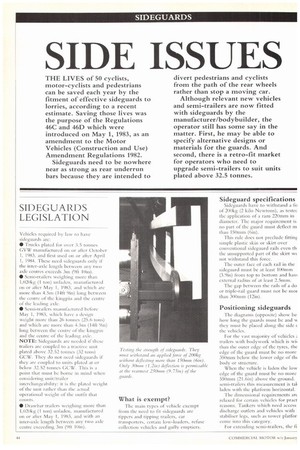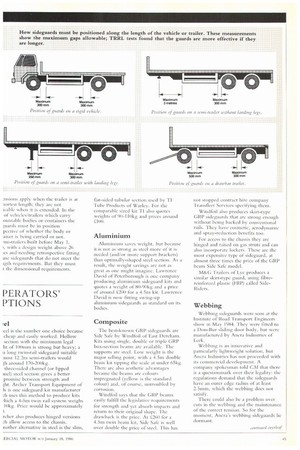SIDEGUARDS LEGISLATION
Page 44

Page 45

If you've noticed an error in this article please click here to report it so we can fix it.
Vehicles required by law to have sideguards are: • Trucks plated for over 3.5 tonnes GVW manufactured on or after Octoher 1, 1983, and first used on or aftcr April 1, 1984, These need sideguards only if the inter-axie length between any two axle centres exceeds 3m (9ft 10in).
• Semi-trailers weighing more than 1,020kg (I ton) unladen, manufactured on Or after May I, 1983, and which are more than 4.5in (I4ft Yin) long between the centre of the kingpin and the centre of the leading axle.
• Semi-trailers manufactured before May 1, 1983, which have a design weight more than 26 tonnes (25.6 tons) and which arc more than 4.5in (14ft Yin) long between the centre of the kingpin and the centre of the leading axle. NOTE: Sideguards are needed if these trailers are coupled to a tractive unit plated above 32.52 tonnes (32 tons) GCW. They do not need sideguards if they are coupled to units plated at or below 32.52 tonnes GCW. This is a point that must be borne in mind when considering unit/trailer interchangeability: it is the plated weight of the unit rather than the actual operational weight of the outfit that counts, • Drawbar trailers weighing more than 1.020kg (I ton) unladen, manufactured on or after May 1, 1983, and with an inter-axle length between any two axle centre exceeding 3m (Oft 10in).
What is exempt?
The main types of vehicle exempt from the need to fit sideguards are tippers and tipping trailers, car transporters, certain low-loaders, refuse collection vehicles and gully emptiers.
Sideguard specifications
Sideguards have to withstand a In of 200kg (2 kilo Newtons), as testec the application of a ram 220mm in diameter. The major requirement is no part of the guard must deflect m than 150mm ((On).
This rule does not preclude fitting simple plastic skin or skirt over conventional sideguard rails even th. the unsupported part of the skirt wc not withstand this force.
The outer face of each rail in the sideguard must be at least 100mm (3.9in) from top to bottom and hayi external radius of at least 2.5min.
The gap between the rails of a do or triple-rail guard must not be ITIOI than 300mm (12in).
Positioning sideguards
The diagrams (opposite) show be: how long the guards must be and NA they must he placed along the side < the vehicles.
For the vast majority of vehicles trailers with bodywork which is wi than the outer edge of the tyres, the edge of the guard must be no more 350nun below the lower edge of tit( body or structure.
When the vehicle is laden the low edge of the guard must be no more 550mm (21.6in) above the ground. semi-trailers this measurement is tat laden with the platform horizontal.
The diniensional requirements art relaxed for certain vehicles for pract reasons. Tankers which need access discharge outlets and vehicles with stabiliser legs, such as tower platfor conic into this category.
For extending semi-trailers, the fi
msions apply when the trailer is at honest length; they arc not icable when it is extended. In the of vehicles/trailers which carry (mutable bodies or containers the ;uards must he in position pective of whether the body or ainer is being carried or not. mn-trailers built before May I.
with i design weight above 26 tes and needing retrospective fitting use sideguards that do not meet the igth requirements. But they must t the dimensional requirements.






















































